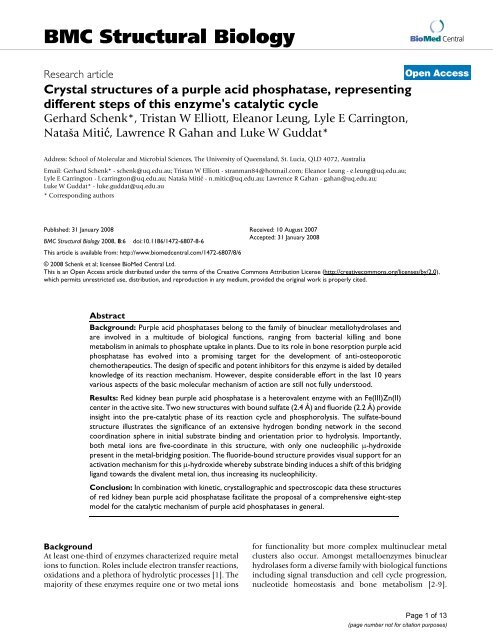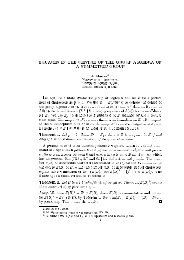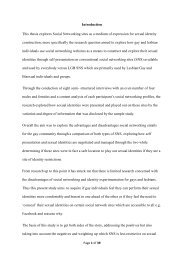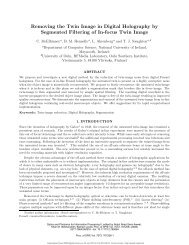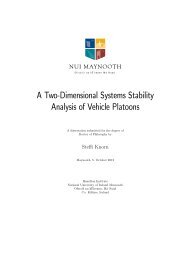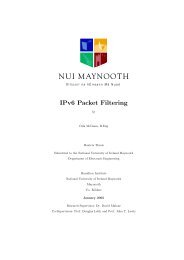Crystal structures of a purple acid phosphatase, representing ...
Crystal structures of a purple acid phosphatase, representing ...
Crystal structures of a purple acid phosphatase, representing ...
Create successful ePaper yourself
Turn your PDF publications into a flip-book with our unique Google optimized e-Paper software.
BMC Structural BiologyBioMed CentralResearch article<strong>Crystal</strong> <strong>structures</strong> <strong>of</strong> a <strong>purple</strong> <strong>acid</strong> <strong>phosphatase</strong>, <strong>representing</strong>different steps <strong>of</strong> this enzyme's catalytic cycleGerhard Schenk*, Tristan W Elliott, Eleanor Leung, Lyle E Carrington,Nataša Mitić, Lawrence R Gahan and Luke W Guddat*Open AccessAddress: School <strong>of</strong> Molecular and Microbial Sciences, The University <strong>of</strong> Queensland, St. Lucia, QLD 4072, AustraliaEmail: Gerhard Schenk* - schenk@uq.edu.au; Tristan W Elliott - stranman84@hotmail.com; Eleanor Leung - e.leung@uq.edu.au;Lyle E Carrington - l.carrington@uq.edu.au; Nataša Mitić - n.mitic@uq.edu.au; Lawrence R Gahan - gahan@uq.edu.au;Luke W Guddat* - luke.guddat@uq.edu.au* Corresponding authorsPublished: 31 January 2008BMC Structural Biology 2008, 8:6 doi:10.1186/1472-6807-8-6This article is available from: http://www.biomedcentral.com/1472-6807/8/6Received: 10 August 2007Accepted: 31 January 2008© 2008 Schenk et al; licensee BioMed Central Ltd.This is an Open Access article distributed under the terms <strong>of</strong> the Creative Commons Attribution License (http://creativecommons.org/licenses/by/2.0),which permits unrestricted use, distribution, and reproduction in any medium, provided the original work is properly cited.AbstractBackground: Purple <strong>acid</strong> <strong>phosphatase</strong>s belong to the family <strong>of</strong> binuclear metallohydrolases andare involved in a multitude <strong>of</strong> biological functions, ranging from bacterial killing and bonemetabolism in animals to phosphate uptake in plants. Due to its role in bone resorption <strong>purple</strong> <strong>acid</strong><strong>phosphatase</strong> has evolved into a promising target for the development <strong>of</strong> anti-osteoporoticchemotherapeutics. The design <strong>of</strong> specific and potent inhibitors for this enzyme is aided by detailedknowledge <strong>of</strong> its reaction mechanism. However, despite considerable effort in the last 10 yearsvarious aspects <strong>of</strong> the basic molecular mechanism <strong>of</strong> action are still not fully understood.Results: Red kidney bean <strong>purple</strong> <strong>acid</strong> <strong>phosphatase</strong> is a heterovalent enzyme with an Fe(III)Zn(II)center in the active site. Two new <strong>structures</strong> with bound sulfate (2.4 Å) and fluoride (2.2 Å) provideinsight into the pre-catalytic phase <strong>of</strong> its reaction cycle and phosphorolysis. The sulfate-boundstructure illustrates the significance <strong>of</strong> an extensive hydrogen bonding network in the secondcoordination sphere in initial substrate binding and orientation prior to hydrolysis. Importantly,both metal ions are five-coordinate in this structure, with only one nucleophilic μ-hydroxidepresent in the metal-bridging position. The fluoride-bound structure provides visual support for anactivation mechanism for this μ-hydroxide whereby substrate binding induces a shift <strong>of</strong> this bridgingligand towards the divalent metal ion, thus increasing its nucleophilicity.Conclusion: In combination with kinetic, crystallographic and spectroscopic data these <strong>structures</strong><strong>of</strong> red kidney bean <strong>purple</strong> <strong>acid</strong> <strong>phosphatase</strong> facilitate the proposal <strong>of</strong> a comprehensive eight-stepmodel for the catalytic mechanism <strong>of</strong> <strong>purple</strong> <strong>acid</strong> <strong>phosphatase</strong>s in general.BackgroundAt least one-third <strong>of</strong> enzymes characterized require metalions to function. Roles include electron transfer reactions,oxidations and a plethora <strong>of</strong> hydrolytic processes [1]. Themajority <strong>of</strong> these enzymes require one or two metal ionsfor functionality but more complex multinuclear metalclusters also occur. Amongst metalloenzymes binuclearhydrolases form a diverse family with biological functionsincluding signal transduction and cell cycle progression,nucleotide homeostasis and bone metabolism [2-9].Page 1 <strong>of</strong> 13(page number not for citation purposes)
BMC Structural Biology 2008, 8:6http://www.biomedcentral.com/1472-6807/8/6Members <strong>of</strong> this group <strong>of</strong> enzymes have evolved into targetsfor the development <strong>of</strong> chemotherapeutic agents.Binuclear metallohydrolases employ variants <strong>of</strong> the samebasic mechanism to catalyze esterolysis <strong>of</strong> a large number<strong>of</strong> substrates, in some cases under inversion <strong>of</strong> stereochemistry,and in others without [2,8,10-13]. In the latter(e.g. alkaline <strong>phosphatase</strong> [13]) a covalently modifiedenzyme intermediate is formed upon nucleophilic attackby a reactive amino <strong>acid</strong> residue. In the former a metalion-bound water ligand is the proposed nucleophile, butits precise identity has been subject to debate and mayvary in different enzymes [2-9,12,14-18]. The majority <strong>of</strong>binuclear metallohydrolases require the presence <strong>of</strong> twometal ions for reactivity, although their precise roles incatalysis and/or substrate or product binding have alsoremained conjectural [2-9,12,14-18]. Note also that somemembers <strong>of</strong> this group <strong>of</strong> enzymes can operate with a singlemetal ion in the active site (e.g. the amino peptidasefrom Aeromonas proteolytica [19], the methionyl aminopetidasefrom Escherichia coli [19] or the metallo-βlactamasefrom Bacillus cereus [20]. The requirement forparticular metal ions and the coordination environments<strong>of</strong> the metal ions may vary significantly amongst members<strong>of</strong> this group <strong>of</strong> enzymes with di-M(II) centers (whereM = Zn, Mn, Ni, Co) being most prevalent. Heterovalentcenters <strong>of</strong> the Fe(III)-M(II) form have also been observedin a group <strong>of</strong> enzymes termed <strong>purple</strong> <strong>acid</strong> <strong>phosphatase</strong>s(PAPs) [2,8,9].PAPs are active in the pH range between 3.0 and 8.0 andhave been purified and characterized from a number <strong>of</strong>mammals and plants [21-28], and PAP-like genes havebeen identified in a limited number <strong>of</strong> microorganisms[29]. The animal enzymes are 35 kDa monomers withredox-active Fe(III)-Fe(II/III) centers where only the heterovalentform is catalytically active [30,31]. Proposed biologicalroles include iron transport, the generation <strong>of</strong>reactive oxygen species and bone resorption [32]. The latterhas made the enzyme a target for the development <strong>of</strong>anti-osteoporotic drugs [32,33]. Plant PAPs are 110 kDahomodimers, containing Fe(III)-Zn(II) or Fe(III)-Mn(II)centers [21-23,34,35], and a recombinant is<strong>of</strong>orm fromsweet potato has been shown to contain a di-iron center[36]. Proposed biological roles for plant PAPs includephosphate metabolism and the generation <strong>of</strong> reactive oxygenspecies [37]. The characteristic <strong>purple</strong> color is due toa charge transfer transition between a tyrosine side-chainand the Fe(III) [38,39].The crystal structure <strong>of</strong> the free red kidney bean PAP (rkb-PAP) and complexes with phosphate (both a reactionproduct and substrate analogue) and tungstate (an inhibitor)are available [40,41]. In addition, <strong>structures</strong> <strong>of</strong> phosphate-boundsweet potato PAP [18] and severalmammalian PAPs (human, pig, rat) have been determined[42-45]. Despite low overall sequence homologybetween PAPs from animal and plant sources their activesites are remarkably conserved, with seven invariant metalligands (Figure 1) [8,9,18,40-47].In this study the <strong>structures</strong> <strong>of</strong> the rkbPAP-sulfate and rkb-PAP-fluoride complexes were determined, providinginsight into what we propose are two crucial steps in itscatalytic mechanism, (i) the pre-catalytic stage, and (ii)the chemical step. In combination with previouslyreported structural, kinetic and spectroscopic data a comprehensivemodel for the reaction mechanism involvingeight steps is proposed.ResultsThe structure <strong>of</strong> the rkbPAP-sulfate complex: a model fora pre-catalytic complexIn this study rkbPAP was co-crystallized with sulfate, anddiffraction data were collected at a resolution (2.4 Å)which is better than that for any previously determinedplant PAP structure [18,40,41]. The Fe(III) and Zn(II) inthis structure are separated by an average distance <strong>of</strong> 3.1 Å(Table 1), similar to that reported for the other rkbPAP <strong>purple</strong> metallohydrolaseFigure Schematic <strong>acid</strong> 1 illustration <strong>phosphatase</strong> <strong>of</strong> (rkbPAP), the active a site representative <strong>of</strong> red kidney binuclear beanSchematic illustration <strong>of</strong> the active site <strong>of</strong> red kidney bean<strong>purple</strong> <strong>acid</strong> <strong>phosphatase</strong> (rkbPAP), a representative binuclearmetallohydrolase. In most (if not all) binuclear metallohydrolasesthe binding affinities <strong>of</strong> the two metal centers vary, withM1 <strong>representing</strong> the tight binding site and M2 the lower affinitysite [8]. In rkbPAP M1 and M2 are occupied by Fe(III) andZn(II), respectively. Combined crystallographic and spectroscopicdata for PAPs indicate the presence <strong>of</strong> a bridging(hydr)oxo group and one terminal water ligand (see text).The presence <strong>of</strong> a terminal Fe(III)-bound hydroxide is currentlydebated with spectroscopic data suggesting its absence[8], but the crystal structure <strong>of</strong> rat PAP supporting its presence[8]. Page 2 <strong>of</strong> 13(page number not for citation purposes)
BMC Structural Biology 2008, 8:6http://www.biomedcentral.com/1472-6807/8/6Table 1: Some interatomic distances (Å).Atoms rkbPAP-sulfate rkbPAP-fluorideFe(III) Zn(II) 3.1 3.5Fe(III) OH - 2.1 -Zn(II) OH - 2.3 -Fe(III) F - - 2.5Zn(II) F - - 2.1OH - SO 2- 4 - O1 2.7 -OH - SO 2- 4 - O3 2.5 -F - Na + - 2.6Na + SO 2- 4 - O1 - 2.4Na + SO 2- 4 - O3 - 2.6His323 C = O OH 3.1 -His323 C = O F - - 3.6Asn201 Nδ2 SO 2- 4 - O3 3.2 -His202 Nε2 SO 2- 4 - O1 3.0 2.9His202 Nε2 SO 2- 4 - O2 3.1 -His295 Nε2 SO 2- 4 - O4 3.3 -His296 Nε2 SO 2- 4 - O3 2.9 -<strong>structures</strong> [40,41]. Spherical electron density is observed2.1 Å from Fe(III) and 2.3 Å from Zn(II) and therefore ina bridging position (Figure 2a). This group is also within3.1 Å <strong>of</strong> the carbonyl oxygen <strong>of</strong> His323, indicating the formation<strong>of</strong> a hydrogen bond (Figure 3). We thereforeassign this density to that <strong>of</strong> a μ-hydroxo group, an interpretationin agreement with a previous study involvingmeasurements <strong>of</strong> the magnetization <strong>of</strong> rkbPAP under catalyticallyrelevant conditions [48]. The Fe(III) is coordinatedby a nitrogen atom from the side chain <strong>of</strong> His325,oxygen atoms from the side chains <strong>of</strong> the chromophoricTyr167, Asp135, Asp164 (which bridges both metal ions),and the bridging hydroxide (Figure 2a). These five ligandscoordinate the Fe(III) in a trigonal bipyramidal geometry,where Asp135, the bridging hydroxide and Tyr167 arecoplanar with Fe(III), and Asp164 and His325 are in axialpositions. Zn(II) is also pentacoordinate, ligated by theside-chain oxygen atoms <strong>of</strong> Asp164 and Asn201, the sidechainnitrogen atoms <strong>of</strong> His286 and His323 and the μ-hydroxide. Its geometry can be described as distortedsquare pyramidal (Figure 2a). Mechanistically, it is importantto stress that the μ-hydroxide group is the only watermolecule present in the active site, and given the location<strong>of</strong> this group the fitting <strong>of</strong> a sixth ligand to either metal isimplausible (Figure 2b).The structure <strong>of</strong> the rkbPAP-fluoride complex: insight intothe chemical step <strong>of</strong> the hydrolytic reactionrkbPAP incubated with fluoride crystallized in a differentspace group and with different unit cell parameters comparedto the sulfate complex (Table 2). Two dimers in theasymmetric unit are observed yielding four copies <strong>of</strong> theactive site. In these <strong>structures</strong> the metal ions are on average3.5 Å apart, a distance significantly larger than thatobserved in any <strong>of</strong> the other rkbPAP <strong>structures</strong> [40,41]. Asmall sphere <strong>of</strong> electron density is observed between thetwo metal ions (Figure 4), in a position similar, but notidentical, to that <strong>of</strong> the μ-hydroxo in the rkbPAP-sulfatecomplex. The center <strong>of</strong> the bridging electron density in therkbPAP-F structure is 2.5 Å and 2.1 Å from Fe(III) andZn(II), respectively (Table 1). In contrast, the bridgingelectron density in rkbPAP-SO 4 is, respectively, 2.1 Å and2.3 Å from Fe(III) and Zn(II). Thus, the bridging ligand isshifted 0.2 Å closer to the Zn(II) and 0.4 Å further awayfrom the Fe(III); its distance to the carbonyl oxygen <strong>of</strong>His323 is 3.6 Å, compared to 3.1 Å observed in the rkb-PAP-SO 4 structure (Figure 2). These differences indicatethat fluoride rather than μ-hydroxide acts as the bridgingligand, as anticipated from kinetic and spectroscopic datacollected for PAPs from pig, human and red kidney bean[15,49,50], and other binuclear metallohydrolases [51].Additional electron densities in the second coordinationsphere, close to the fluoride, are tentatively assigned to asodium ion and a sulfate ion (see Methods section). Thesodium ion may <strong>of</strong>fset the charge <strong>of</strong> the metal bridgingfluoride group, and possibly prevents cations (i.e. sulfate,acetate) from binding to the second coordination sphere.DiscussionThe study <strong>of</strong> the reaction mechanism <strong>of</strong> PAP-catalyzedhydrolysis has received considerable attention over thepast decade, with much <strong>of</strong> the focus directed towards theinvestigation <strong>of</strong> individual steps <strong>of</strong> the catalytic cycle. Variousstages <strong>of</strong> the mechanism have been subject to debate,none more so than the identity <strong>of</strong> the reaction-initiatingnucleophile and the mode <strong>of</strong> substrate binding[2,3,8,12,14-18,28,35,49,50,52-55]. In this study, we provideinsight into these two points <strong>of</strong> contention by combiningthe obtained structural data with previouslyreported spectroscopic, kinetic and crystallographic information,and a comprehensive eight-step model for thereaction cycle is proposed.The pre-catalytic phase <strong>of</strong> the reaction cycleThe rate <strong>of</strong> the oxidation <strong>of</strong> reduced pig PAP by[Fe(III)(CN) 6 ] 3- displays saturation behavior as the concentration<strong>of</strong> the oxidant is increased [56]. The model proposedto explain the observed saturation behavior invokesan initial rapid formation <strong>of</strong> an enzyme-[Fe(III)(CN) 6 ] 3-complex, followed by a considerably slower catalytic step.This conclusion was further augmented by measurements<strong>of</strong> the rate <strong>of</strong> phosphate binding to the Fe(III) <strong>of</strong> pig PAPusing stopped-flow spectroscopy, leading to the suggestionthat the substrate is also likely to associate initiallywith the enzyme, forming a catalytically non-competentcomplex (pre-catalytic complex) [16,56]. It was speculatedthat interactions between conserved histidine residuesin the active site may be responsible for theformation <strong>of</strong> this pre-catalytic complex (His92 andHis195 in pig PAP, corresponding to His202 and His296Page 3 <strong>of</strong> 13(page number not for citation purposes)
BMC Structural Biology 2008, 8:6http://www.biomedcentral.com/1472-6807/8/6Stereodiagram <strong>of</strong> the active site <strong>of</strong> the rkbPAP-fluoride complexFigure 4Stereodiagram <strong>of</strong> the active site <strong>of</strong> the rkbPAP-fluoride complex. F o -F c electron density for the bridge is overlayed. The fluoridereplaces the hydroxide in the bridging position. General legend: Fe(III) is in tan, Zn(II) in grey, sodium in <strong>purple</strong>, fluoride in cyan,carbon in green, oxygen in red, nitrogen in blue and sulphur in orange. Hydrogen bonds and other contacts are shown asdashed lines.sulfate oxygens (note that due to its proximity to threedonor oxygens the μ-hydroxide is able to form hydrogenbond interactions with each <strong>of</strong> these atoms (Figure 3); thecrystal structure thus displays the averaged hydrogenbond pattern, evident as a "trifurcated" interaction). Alternatively,it is possible that due to the presence <strong>of</strong> the sulfategroup the pK a <strong>of</strong> the bridging hydroxide is sufficientlyelevated so that at pH 4.0 (crystallization condition) it isprotonated; in this case each <strong>of</strong> the protons may pointtowards one sulfate oxygen atom. At present the two possibilitiescannot be distinguished. The intricacies <strong>of</strong> theextended hydrogen bond network are further illustratedby bi- and trifurcated interactions involving three <strong>of</strong> thefour oxygen atoms <strong>of</strong> sulfate and several conserved firstand second coordination sphere residues <strong>of</strong> rkbPAP (Figure3). At pH 4.0 (crystallization condition) sulfate isexpected to enter the active site in its dianionic (SO 42- )form. However, due to its extensive hydrogen bondinginteractions the effective charge <strong>of</strong> sulfate is lowered,reducing its electrostatic attraction for the positivelycharged metal cluster. Thus, the rkbPAP-sulfate complexdemonstrates, for the first time, how the pre-catalyticcomplex predicted from stopped-flow measurements[16,52,56] may be formed and stabilized in the secondcoordination sphere <strong>of</strong> the enzyme. Note, however, thatin addition to mimicking the pre-catalytic stage the boundsulfate may also mimic the penultimate phase <strong>of</strong> catalysis,where the reaction product phosphate is still bound to theactive site (see below).In the absence <strong>of</strong> crystallographic data for the complexbetween an actual substrate and rkbPAP, in silico dockinghas been used to estimate the most likely binding mode<strong>of</strong> the leaving group based on the conformation <strong>of</strong> the sulfategroup in the proposed pre-catalytic state (Figure 5).Similarly, the binding mode <strong>of</strong> the leaving group in therkbPAP-phosphate complex (which is likely to representthe product-bound state after hydrolysis, see above) wasalso modeled (see Methods section for details), illustratingthe required movement <strong>of</strong> the substrate in the activesite during catalysis.A sulfate-bound structure has also been reported for ratPAP [43], with a first coordination sphere geometry similarto that <strong>of</strong> rkbPAP (Figure 2b). However, in contrast tothe latter in the rat enzyme SO 42- is bound in a monodentatemanner to the metal ion at the M2 site (Figure 1) andis stabilized by hydrogen bonding interactions withAsn112 (Asn201) and His113 (His202; residues numberedin brackets indicate the corresponding residues inrkbPAP). A similar mode <strong>of</strong> sulfate coordination has beenobserved in the Ser/Thr protein <strong>phosphatase</strong> from bacteriophageλ (λPP) [57]. Since kinetic and spectroscopicexperiments with mammalian PAPs indicate that a monodentatecoordination <strong>of</strong> the substrate to site M2 precedesPage 6 <strong>of</strong> 13(page number not for citation purposes)
BMC Structural Biology 2008, 8:6http://www.biomedcentral.com/1472-6807/8/6and Figure Model on <strong>of</strong> the 5substrate structure (para-nitrophenyl <strong>of</strong> the phosphate phosphate) complex (magenta binding to carbons) rkbPAP based on the sulfate complex (this study; cyan carbons)Model <strong>of</strong> substrate (para-nitrophenyl phosphate) binding to rkbPAP based on the sulfate complex (this study; cyan carbons)and on the structure <strong>of</strong> the phosphate complex (magenta carbons). The ' symbol represents a residue from the neighboringsubunit.hydrolysis [12,14,16,17], the rat PAP and λPP <strong>structures</strong>are thus likely to represent the step following the formation<strong>of</strong> the pre-catalytic complex (but preceding hydrolysis).The different binding modes <strong>of</strong> sulfate in rat andrkbPAP may be ascribed to: (1) His216 (His296) in the ratenzyme being prevented from forming a hydrogen bondwith sulfate due to the presence <strong>of</strong> a Zn(II) ion (added inthe crystallization buffer); (2) His295 in rkbPAP (Figure2a) being replaced by Glu215 in rat PAP, thus altering thechemistry at this site; (3) the μ-hydroxide in the rat PAPstructure being deprotonated under the conditions <strong>of</strong>crystallization (pH 7.5); and (4) the di-iron rat enzymewas likely to be crystallized in its inactive diferric form.Thus, in the rat PAP structure the combination <strong>of</strong> reducedhydrogen bonding interactions and increased positivecharge in the metal cluster is likely to increase the electrostaticattraction between the metal center and sulfate,leading to direct metal ion coordination.The chemical step <strong>of</strong> the catalytic cycleApart from providing insight into a possible mode <strong>of</strong>interaction between substrate and enzyme, the rkbPAPsulfatestructure also identifies the metal ion-bridginghydroxide as a candidate nucleophile (Figure 2a). A similarconclusion was reached using a range <strong>of</strong> spectroscopictechniques, including electron-nuclear double resonance(ENDOR) [17] and X-ray absorption spectroscopy [15].Fluoride has been shown to inhibit a number <strong>of</strong> metalloenzymes,and in PAPs is able to replace nucleophilichydroxides coordinated to the metal ions [15,49-51,58,59]. Specifically, for rkbPAP fluoride is a competitiveinhibitor with a K i ~170 μM at pH 4.90 [50]. Theabove observation that the bridging hydroxide is the onlynucleophile found in the active site <strong>of</strong> the rkbPAP-SO 4crystal structure (Figure 2a) leads to the suggestion thatfluoride is able to displace this group, thus forming a μ-fluoro binuclear center. This interpretation is supportedby the crystal structure <strong>of</strong> the rkbPAP-fluoride complex(Figure 4). Importantly, this structure lends credence to anactivation mechanism for the hydrolysis-initiating nucleophile.Previous studies proposed a terminal M1-boundhydroxide as the most likely candidate as the nucleophile,and it was suggested that the nucleophilicity <strong>of</strong> a bridginghydroxide would be too low to assure efficient reactivity[12,14,52]. However, the rkbPAP-SO 4 structure (seeabove) and ENDOR measurements <strong>of</strong> pig PAP [17] indicatethat there is no terminal water ligand at the M1 site inthe resting and pre-catalytic state (Figures 1 and 3). Thelatter study [17] suggested that the reduced nucleophilicity<strong>of</strong> the bridging hydroxide is compensated by anincreased electrophilicity <strong>of</strong> the substrate when comparingthe possibilities <strong>of</strong> (i) a terminally coordinated nucleophileand terminally coordinated substrate, with (ii) abridging nucleophile and bridging substrate. Furthermore,binding <strong>of</strong> the substrate decreases the couplinginteraction between the two metal centers, indicating alengthening <strong>of</strong> the metal-metal distance and a concomitantadditional increase <strong>of</strong> the nucleophilicity <strong>of</strong> thebridge by effectively shifting it towards the divalent cation("quasi-monodentate" ligation) [17]. This substrateinducedshift <strong>of</strong> the bridging ligand is also illustrated forfluoride-bound pig PAP by a combination <strong>of</strong> inhibitionkinetics, resonance Raman, electron paramagnetic reso-Page 7 <strong>of</strong> 13(page number not for citation purposes)
BMC Structural Biology 2008, 8:6http://www.biomedcentral.com/1472-6807/8/6nance and extended X-ray absorption fine structure spectroscopies,which have demonstrated that in the ternaryenzyme-fluoride-substrate complex the fluoride ion islocated closer to the divalent metal ion [15]. Furthermore,studies involving absorption spectroscopy and (magnetic)circular dichroism have also indicated that the binding <strong>of</strong>substrate analogues to pig PAP decreases the exchangecoupling with an accompanying red-shift <strong>of</strong> the chargetransfer transition [39]. These observations were interpretedin terms <strong>of</strong> a weakening <strong>of</strong> the Fe(III)-μ-OH bond.Thus, both μ-fluoride and μ-hydroxide in PAP are affectedin a similar manner when substrate binds to the enzyme.Here, the comparison between the sulfate- and fluorideboundrkbPAP <strong>structures</strong> corroborates this mechanism forthe activation <strong>of</strong> the bridging nucleophile. The metalmetaldistance in rkbPAP-F is elongated by ~0.4 Å and themetal ion-bridging ligand is shifted towards M2 and awayfrom M1 (Table 1). In summary, the combined structural,spectroscopic and kinetic data support the proposal thatsubstrate binding triggers the shift <strong>of</strong> the μ-hydroxide intoa "quasi-terminal" position, thus increasing its nucleophilicity.A comprehensive model for the catalytic mechanismBased on all <strong>of</strong> the available data for PAPs the followingmodel <strong>of</strong> a comprehensive mechanism <strong>of</strong> catalysisemerges (Figure 6). Monitoring the oxidation (and thusinactivation) <strong>of</strong> Fe(III)-Fe(II) pig PAP by [Fe(CN) 6 ] 3- hasprovided evidence for the formation <strong>of</strong> a pre-catalyticcomplex in the initial phase <strong>of</strong> the reaction, where thephosphate group <strong>of</strong> the substrate does not directly coordinateto the metal ions [16,52,56]. The structure <strong>of</strong> rkb-PAP-SO 4 demonstrates a plausible model for the precatalyticcomplex where the substrate mimic, sulfate, isbound in the second coordination sphere, an arrangementstabilized via an extensive hydrogen bonding network(Figure 3). The bridging μ-hydroxide appears to playan essential role in the initial binding and orientation <strong>of</strong>the substrate (Figure 2a). In this pre-catalytic state bothmetal ion sites are five-coordinate with distorted trigonalbipyramidalgeometry. The only solvent molecule in theactive site is the μ-hydroxide. Since an ENDOR study providedevidence for the presence <strong>of</strong> an additional water ligandbound terminally to the metal ion in the M2 site inresting pig PAP (Figure 1) [17], the formation <strong>of</strong> the precatalyticcomplex may thus lead to the expulsion <strong>of</strong> thislabile terminal water ligand (Figure 6a).The formation <strong>of</strong> the pre-catalytic complex with the concomitantexpulsion <strong>of</strong> the M2 site bound terminal waterligand generates a vacant coordination position for anoxygen atom <strong>of</strong> the phosphate group (monodentate coordination),as exemplified in sulfate-bound <strong>structures</strong> <strong>of</strong>rat PAP and λPP (Figure 6b) [43,57]. Coordination <strong>of</strong> thesubstrate to the M2 site and subsequent structural rearrangementsin the M1 site permit the formation <strong>of</strong> a μ-1,3substrate complex (Figure 6c). In support <strong>of</strong> this hypothesisEPR measurements have indicated that, in fluorideinhibitedpig PAP, substrates and the reaction productphosphate bind in a similar metal ion-bridging μ-1,3mode to the binuclear center [15]. The resulting μ-1,3phosphate complex, visualized in the structure <strong>of</strong> oxidized(inactive) pig PAP [42], places the phosphorus atomin an ideal position for a nucleophilic attack by the μ-hydroxide moiety (Figure 6c).The proposed structural rearrangements in the M1 site arelikely to be mediated via the hydrogen bond network inthe second coordination sphere. A related observation hasbeen made in the mononuclear soybean lipoxygenase-1where the degree <strong>of</strong> coordination flexibility mediated viaa hydrogen bond network in the second coordinationsphere directly correlates with the reactivity <strong>of</strong> thisenzyme [60]. Superposition <strong>of</strong> the rkbPAP <strong>structures</strong> withbound sulfate, fluoride and phosphate demonstrates thatthe geometry <strong>of</strong> the protein ligands in the M2 site and theposition <strong>of</strong> the M2 metal ion (Zn) are, within experimentalerror, fixed. However, for the M1 site in the fluoridebound structure the metal ion is shifted by up to 0.4 Åwhen compared to rkbPAP-SO 4 and rkbPAP-PO 4 whichthen results in compensatory rotations <strong>of</strong> the side chains<strong>of</strong> Tyr167 and His325.Nucleophilic attack by the μ-hydroxide and esterolysis <strong>of</strong>the substrate (depending on the basicity <strong>of</strong> the leavinggroup these steps may occur in a concerted or sequentialmanner [18]) leaves the phosphate bound to the activesite in a tripodal geometry (Figure 6d). This mode <strong>of</strong> coordinationhas been observed in the crystal <strong>structures</strong> <strong>of</strong>sweet potato PAP and di-Ni(II) urease, both with boundphosphate, and di-Mn(II) λPP, with bound sulfate[18,57,61]. Hydrogen bond interactions with the carbonyloxygen <strong>of</strong> the metal ion ligand His323 may stabilizethis tripodal arrangement, at least at low pH [18]. In Figure7 the movement required for the phosphate group <strong>of</strong>the substrate from initial binding in the pre-catalytic complexto the tripodal arrangement following hydrolysis isillustrated.At this point it is important to point out that evidence hasrecently emerged that suggests that the chemical step maybe affected by both the substrates used in the reaction andthe metal ion composition <strong>of</strong> the active site [53-55]. Specifically,it could be shown that both pig and rkbPAPhydrolyze both ester bonds in the diester substratemethyl-pNPP in a processive manner [53]. This observationis interpreted in terms <strong>of</strong> an initial monodentatecoordination <strong>of</strong> the substrate to the M2-site, followed bya nucleophilic attack by a terminal Fe(III)-bound hydroxide.This process is also observed in reactions catalyzed byPage 8 <strong>of</strong> 13(page number not for citation purposes)
BMC Structural Biology 2008, 8:6http://www.biomedcentral.com/1472-6807/8/6 Proposed Figure 6 mechanism <strong>of</strong> binuclear metallohydrolase-catalyzed esterolysisProposed mechanism <strong>of</strong> binuclear metallohydrolase-catalyzed esterolysis. Following the binding <strong>of</strong> the substrate in a pre-catalyticcomplex, structural rearrangements lead to "quasi-monodentate" and bidentate coordination <strong>of</strong> the μ-hydroxide andphosphate groups, respectively (a-c). Nucleophilic attack by the μ-hydroxide is followed by the release <strong>of</strong> the leaving group,and the active site is returned to its resting state by the exchange <strong>of</strong> the bound phosphate group by two water molecules (d-h).A terminal M1-bound hydroxide is observed in the structure <strong>of</strong> rat PAP (b), which appears to be an artefact <strong>of</strong> crystallization[46] and is not supported by solution studies on resting PAP [17]. Where available crystallographic pictures <strong>of</strong> relevant activesite <strong>structures</strong> are included. (a) rkbPAP-sulfate complex; (b) rat PAP-sulfate complex [43]; (c) pig PAP-phosphate complex [42];(d) sweet potato PAP-phosphate complex [18] ; (e) rkbPAP-phosphate complex [41]; (h) rkbPAP [40] (the bridging and terminalM2-bound water ligands were modelled based on ENDOR studies [17]).a Fe(III)Zn(II) biomimetic <strong>of</strong> PAPs, where only the terminalhydroxide is sufficiently nucleophilic to inducehydrolysis [62]. Subsequently, but only in the enzymecatalyzedreaction, the bridging hydroxide initiates thecleavage <strong>of</strong> the second ester bond <strong>of</strong> the substrate in amanner similar to that described in the preceding paragraph[53]. Since no terminal Fe(III)-bound hydroxideappears to be present in the resting state <strong>of</strong> PAPs (seeabove) the interaction between the diester substrate andthe enzyme active site may lead to the introduction <strong>of</strong> anadditional water ligand.The regeneration <strong>of</strong> the resting form <strong>of</strong> the enzyme, whichrequires the removal <strong>of</strong> the phosphate from the active site,is currently not well understood. A plausible sequenceinvolves the rearrangement <strong>of</strong> the bound phosphategroup from tripodal (Figure 6d) to μ-1,3 coordination(Figure 6e) via a rotation around the axis formed by thetwo oxygen atoms <strong>of</strong> phosphate that are terminally coordinatedto the metal ions in sites M1 and M2. Althoughwe are not aware <strong>of</strong> a precedent where the simultaneousloss <strong>of</strong> two Lewis interactions is invoked as part <strong>of</strong> a catalyticmechanism, the resulting μ-1,3-PO 4 complex hasbeen observed in the structure <strong>of</strong> rkbPAP, where a μ-Page 9 <strong>of</strong> 13(page number not for citation purposes)
BMC Structural Biology 2008, 8:6http://www.biomedcentral.com/1472-6807/8/6[42] Figure Overlay and 7<strong>of</strong> the the phosphate rkbPAP-sulfate as observed complex in sweet (with the potato bridging PAP [18] oxygen in red), the bridging hydroxide (pink) as observed in pig PAPOverlay <strong>of</strong> the rkbPAP-sulfate complex (with the bridging oxygen in red), the bridging hydroxide (pink) as observed in pig PAP[42] and the phosphate as observed in sweet potato PAP [18]. The image demonstrates a plausible trajectory for the substratewith the bridging hydroxide as the nucleophile in catalysis. Inversion <strong>of</strong> configuration around the phosphorous atom isobserved. General legend: Fe(III) is in tan, Zn(II) in grey, carbon in green, oxygen in red, nitrogen in blue, sulphur in orange,hydrogen in white and phosphorous in magenta.hydroxide bridge was also modelled into the active sitealthough this ligand could not be identified in the 2.7 Åelectron density map [41]. It is speculated that the loss <strong>of</strong>strain is a major contributing force to drive the conversionfrom a tripodal to a μ-1,3 coordination mode. No experimentaldata for the subsequent steps in regeneration areyet available but a possible mechanism is depicted in Figures6f–6h. The exchange <strong>of</strong> the M2-coordinated phosphateoxygen atom by water leads to a monodentate, M1-bound phosphate. Due to geometric constraints the M2-bound water ligand is likely to form a hydrogen bondwith the phosphate group (Figure 6f), thus facilitating itsdeprotonation. The M2-hydroxide then interacts with themetal ion in the M1 site, thus regenerating the μ-hydroxidebridge, weakening the M1-phosphate bond, and providinga vacant coordination position for another watermolecule in the M2 site (Figure 6g). The subsequentrelease <strong>of</strong> the phosphate group enables the M1 site toregain resting state, trigonal-bipyramidal geometry (Figure6h). Although the precise details <strong>of</strong> the phosphaterelease mechanism remain unknown it is conceivable thatthe anion is shuttled away from the active site via the secondcoordination sphere, where it may interact throughhydrogen bonds with histidine residues in a manner analogousto that <strong>of</strong> the substrate in the pre-catalytic complex(Figure 2a). It appears thus likely that the reversible interactionsbetween the phosphate group and the secondcoordination sphere trigger conformational changes thattake place during a catalytic turnover in the active site <strong>of</strong>PAPs.ConclusionBy a combination <strong>of</strong> crystallographic, kinetic and spectroscopicdata an eight-step model for the reaction mechanism<strong>of</strong> rkbPAP-catalyzed hydrolysis has been developed.Modifications <strong>of</strong> this basic mechanism are anticipateddepending on the substrates used. The mechanistic modeldeveloped here may also be relevant for several otherbinuclear enzymes from the binuclear metallohydrolasefamily. The observed binding mode for sulfate provides anew lead in the design <strong>of</strong> metallohydrolase-selective therapeutics.MethodsMaterialsAll reagents were analytical grade and from Sigma.Protein purification and characterizationrkbPAP was purified as described previously [21] concentratedto 25 mg/mL and stored at 4°C in 0.5 M NaCl. Samplesfor crystallization were > 95% pure, as judged by SDS-PAGE analysis. Metal analysis was carried out using inductivelycoupled plasma mass spectrometry and indicatedthe presence <strong>of</strong> 1.0 Fe, 0.9 Zn, and trace amounts <strong>of</strong> Mnand Cu per active site.Protein crystallization<strong>Crystal</strong>s were grown by vapor diffusion, with hangingdrops consisting <strong>of</strong> 5 μl <strong>of</strong> well solution and 5 μl <strong>of</strong> theconcentrated protein solution. For the sulfate complex,the well solution for crystallization consisted <strong>of</strong> 2 Mammonium sulfate and 0.1 M sodium acetate, pH 4.0.Page 10 <strong>of</strong> 13(page number not for citation purposes)
BMC Structural Biology 2008, 8:6http://www.biomedcentral.com/1472-6807/8/6<strong>Crystal</strong>s <strong>of</strong> the fluoride complex were obtained by co-crystallization<strong>of</strong> rkbPAP in the presence <strong>of</strong> 50 mM NaF (anexcess <strong>of</strong> ~550 fold). The well solution for these crystalsconsisted <strong>of</strong> 2.3 M ammonium sulfate and 0.1 M sodiumacetate pH 4.0. No suitable condition for cryoprotectioncould be found for the sulfate crystals, therefore data wereobtained at room temperature. The fluoride crystal wascryoprotected in a solution containing 30% (v/v) glyceroland 70% (v/v) well solution.Diffraction data collection and structural refinementAll X-ray data were collected using an Raxis IV ++ imagingplate and an FR-E rotating anode generator operated at acurrent <strong>of</strong> 45 mA and a voltage <strong>of</strong> 45 kV. The program<strong>Crystal</strong>clear 1.3.6 [63] was used for the integration andscaling <strong>of</strong> the data. The sulfate and fluoride bound crystalswere not isomorphous with any <strong>of</strong> the previously determined<strong>structures</strong> <strong>of</strong> rkbPAP or with each other. Therefore,these <strong>structures</strong> were solved by molecular replacement inthe program EPMR [64] using the polypeptide coordinates<strong>of</strong> the rkbPAP-phosphate complex (PDB code 4KBP[41]). Rounds <strong>of</strong> refinement and modelling were undertakenusing the programs CNS [65] and O [66], respectively.The crystal <strong>structures</strong> <strong>of</strong> rkbPAP in the presence <strong>of</strong> sulfateor fluoride were determined by molecular replacementand refined to 2.4 Å with an R free value <strong>of</strong> 0.2113 and to2.2 Å with an R free <strong>of</strong> 0.2543, respectively (Table 2). Thesulfate complex crystallized with one dimer in the asymmetricunit while the fluoride complex has two such dimers.The overall <strong>structures</strong> <strong>of</strong> the polypeptides stronglyresemble those <strong>of</strong> the previously determined <strong>structures</strong> <strong>of</strong>free rkbPAP and the phosphate and tungstate bound complexes<strong>of</strong> this enzyme [41] with r.m.s.d. values for all Cαatoms ranging from 0.2 to 0.3 Å. For the sulfate-boundstructure the asymmetric unit (and final model) consisted<strong>of</strong> two polypeptide subunits <strong>of</strong> 423 residues (9–432), twoFe(III), two Zn(II), two sulfate groups, eight N-acetyl glucosamineresidues and 399 water molecules. The firsteight N-terminal amino <strong>acid</strong> residues <strong>of</strong> the polypeptidein each subunit were not visible. For the fluoride structurethe asymmetric unit (and final model) consisted <strong>of</strong> fourpolypeptide subunits <strong>of</strong> 423 residues (9–432), fourFe(III), four Zn(II), four fluoride ions, eight sodium ions,eight sulfate groups, sixteen N-acetyl glucosamine residuesand 547 water molecules. Within the crystallizationsolution, the only other small molecules present at adetectable concentration are acetate and glycerol. The fitting<strong>of</strong> these molecules into the electron density occupiedby the sulfate ions was tested but they did not fit the contoursas precisely as sulfate. Furthermore, in F o -F c differencemaps the electron density at the location <strong>of</strong> thesulfate atoms was generally between 7.5–8.0 σ above themean, compared to 3.0–4.0 σ above the mean for othernearby atoms which we assign as either oxygen, fluorideor sodium. The backbone dihedral angles (Ramachandranplot values) <strong>of</strong> His 323, Ile 340 and Ala 243 are in disallowedregions in all polypeptides <strong>of</strong> both complexes.Only His323 is within the active site. In all <strong>of</strong> the rkbPAP<strong>structures</strong> previously determined this residue has similardihedral angle values [40,41]. Coordinates and structurefactors have been deposited into the protein databankwith accession numbers 2QFR and 2QFB for rkbPAP-sulfateand rkbPAP-fluoride, respectively. All figures weregenerated with the progam PyMOL [67].For in silico docking studies a three dimensional model <strong>of</strong>the substrate para-nitrophenyl phosphate was constructedusing Sketcher in Insight2000. The phosphorous and theoxygen atoms <strong>of</strong> the substrate were superimposed ontosulfate in the rkbPAP-sulfate complex or phosphate in therkbPAP-phosphate [41] complex. In both dockings thearomatic ring <strong>of</strong> para-nitrophenyl phosphate was thenrotated to make optimal contacts with the nearby amino<strong>acid</strong>s <strong>of</strong> the enzyme.AbbreviationsENDOR – electron-nuclear double resonance; λPP – Ser/Thr protein <strong>phosphatase</strong> from bacteriophage λ; PAP –<strong>purple</strong> <strong>acid</strong> <strong>phosphatase</strong>; rkbPAP – red kidney bean <strong>purple</strong><strong>acid</strong> <strong>phosphatase</strong>; pNPP – para-nitrophenolphosphateAuthors' contributionsAll authors have read and approved the final version <strong>of</strong>the manuscript. GS was responsible for the conceptualization<strong>of</strong> experiments, analysis and interpretation <strong>of</strong> data,and drafting and critical review <strong>of</strong> the manuscript. TWEcarried out protein purification, acquisition and analysis<strong>of</strong> data. EL was assisting acquisition and analysis <strong>of</strong> data.NM was involved in analysis <strong>of</strong> data and was responsiblefor the revision <strong>of</strong> the manuscript. LEC was involved inprotein purification and acquisition <strong>of</strong> data. LRG wasinvolved in conceptualization <strong>of</strong> experiments, interpretation<strong>of</strong> data, and critical review <strong>of</strong> the manuscript. LWGwas responsible for the conceptualization <strong>of</strong> experiments,acquisition, analysis and interpretation <strong>of</strong> data, and criticalreview <strong>of</strong> the manuscript.AcknowledgementsThis work was funded by a grant from the Australian Research Council(DP0558652). X-ray data were measured using facilities provided by theUniversity <strong>of</strong> Queensland Macromolecular X-ray <strong>Crystal</strong>lography Facility.References1. Lippard SJ, Berg JM: Principles <strong>of</strong> Bioinorganic Chemistry, UniversityScience Books, Mill Valley, CA; 1994.2. Wilcox DE: Binuclear metallohydrolases. Chem Rev 1996,96:2435-2458.3. Dismukes GC: Manganese enzymes with binuclear active sites.Chem Rev 1996, 96:2909-2926.Page 11 <strong>of</strong> 13(page number not for citation purposes)
BMC Structural Biology 2008, 8:6http://www.biomedcentral.com/1472-6807/8/64. Barford D, Das AK, Egl<strong>of</strong>f MP: The structure and mechanism <strong>of</strong>protein <strong>phosphatase</strong>s: Insights into catalysis and regulation.Annu Rev Biophys Biomol Struct 1998, 27:133-164.5. Jackson MD, Denu JM: Molecular reactions <strong>of</strong> protein <strong>phosphatase</strong>s– Insights from structure and chemistry. Chem Rev2001, 101:2313-2340.6. Lowther WT, Matthews BW: Structure and function <strong>of</strong> themethionine aminopeptidases. Biochimica Et Biophysica Acta-ProteinStructure and Molecular Enzymology 2000, 1477:157-167.7. Solomon EI, Brunold TC, Davis MI, Kemsley JN, Lee SK, Lehnert N,Neese F, Skulan AJ, Yang YS, Zhou J: Geometric and electronicstructure/function correlations in non-heme iron enzymes.Chem Rev 2000, 100:235-349.8. Mitic N, Smith SJ, Neves A, Guddat LW, Gahan LR, Schenk G: Thecatalytic mechanisms <strong>of</strong> binuclear metallohydrolases. ChemRev 2006, 106:3338-3363.9. Sträter N, Lipscomb WN, Klabunde T, Krebs B: Two-metal ioncatalysis in enzymatic acyl- and phosphoryl-transfer reactions.Angewandte Chemie-International Edition in English 1996,35:2024-2055.10. Mueller EG, Crowder MW, Averill BA, Knowles JR: Purple Acid-Phosphatase – a Diiron Enzyme That Catalyzes a DirectPhospho Group Transfer to Water. J Am Chem Soc 1993,115:2974-2975.11. Wynne CJ, Hamilton SE, Dionysius DA, Beck JL, Dejersey J: Studieson the Catalytic Mechanism <strong>of</strong> Pig Purple Acid-Phosphatase.Arch Biochem Biophys 1995, 319:133-141.12. Merkx M, Pinkse MWH, Averill BA: Evidence for nonbridgedcoordination <strong>of</strong> p-nitrophenyl phosphate to the dinuclearFe(III)-M(II) center in bovine spleen <strong>purple</strong> <strong>acid</strong> <strong>phosphatase</strong>during enzymatic turnover. Biochemistry 1999, 38:9914-9925.13. O'Brien PJ, Herschlag D: Alkaline <strong>phosphatase</strong> revisited:Hydrolysis <strong>of</strong> alkyl phosphates. Biochemistry 2002, 41:3207-3225.14. Aquino MAS, Lim JS, Sykes AG: Mechanism <strong>of</strong> the Reaction <strong>of</strong>Different Phosphates with the Iron(Ii)Iron(Iii) Form <strong>of</strong> PurpleAcid-Phosphatase from Porcine Uteri (Uter<strong>of</strong>errin). Journal<strong>of</strong> the Chemical Society-Dalton Transactions 1994:429-436.15. Wang XD, Ho RYN, Whiting AK, Que L: Spectroscopic characterization<strong>of</strong> a ternary <strong>phosphatase</strong>-substrate-fluoride complex.Mechanistic implications for dinuclear hydrolases. J AmChem Soc 1999, 121:9235-9236.16. Twitchett MB, Schenk G, Aquino MAS, Yiu DTY, Lau TC, Sykes AG:Reactivity <strong>of</strong> M-II metal-substituted derivatives <strong>of</strong> pig <strong>purple</strong><strong>acid</strong> <strong>phosphatase</strong> (Uter<strong>of</strong>errin) with phosphate. Inorg Chem2002, 41:5787-5794.17. Smoukov SK, Quaroni L, Wang XD, Doan PE, H<strong>of</strong>fman BM, Que L:Electron-nuclear double resonance spectroscopic evidencefor a hydroxo-bridge nucleophile involved in catalysis by adinuclear hydrolase. J Am Chem Soc 2002, 124:2595-2603.18. Schenk G, Gahan LR, Carrington LE, Mitić N, Valizadeh M, HamiltonSE, de Jersey J, Guddat LW: Phosphate forms an unusual tripodalcomplex with the Fe-Mn center <strong>of</strong> sweet potato <strong>purple</strong><strong>acid</strong> <strong>phosphatase</strong>. Proc Natl Acad Sci USA 2005, 102:273-278.19. Bennett B, Antholine WE, D'Souza VM, Chen GJ, Ustinyuk L, HolzRC: Structurally distinct active sites in the copper(II)-substitutedaminopeptidases from Aeromonas proteolytica andEscherichia coli. J Am Chem Soc 2002, 124:13025-13034.20. Wommer S, Rival S, Heinz U, Galleni M, Frere JM, Franceschini N,Amicosante G, Rasmussen B, Bauer R, Adolph HW: Substrate-activatedzinc binding <strong>of</strong> metallo-beta-lactamases – Physiologicalimportance <strong>of</strong> the mononuclear enzymes. J Biol Chem 2002,277:24142-24147.21. Beck JL, McConachie LA, Summors AC, Arnold WN, de Jersey J,Zerner B: Properties <strong>of</strong> a Purple Phosphatase from Red KidneyBean – a Zinc-Iron Metalloenzyme. Biochim Biophys Acta1986, 869:61-68.22. Schenk G, Ge YB, Carrington LE, Wynne CJ, Searle IR, Carroll BJ,Hamilton S, de Jersey J: Binuclear metal centers in plant <strong>purple</strong><strong>acid</strong> <strong>phosphatase</strong>s: Fe-Mn in sweet potato and Fe-Zn in soybean.Arch Biochem Biophys 1999, 370:183-189.23. Durmus A, Eicken C, Sift BH, Kratel A, Kappl R, Huttermann J, KrebsB: The active site <strong>of</strong> <strong>purple</strong> <strong>acid</strong> <strong>phosphatase</strong> from sweetpotatoes (Ipomoea batatas) – Metal content and spectroscopiccharacterization. Eur J Biochem 1999, 260:709-716.24. Campbell HD, Dionysius DA, Keough DT, Wilson BE, de Jersey J,Zerner B: Iron-Containing Acid-Phosphatases – Comparison<strong>of</strong> Enzymes from Beef Spleen and Pig Allantoic Fluid. BiochemBiophys Res Commun 1978, 82:615-620.25. Ketcham CM, Baumbach GA, Bazer FW, Roberts RM: The Type-5,Acid-Phosphatase from Spleen <strong>of</strong> Humans with Hairy-CellLeukemia – Purification, Properties, Immunological Characterization,and Comparison with Porcine Uter<strong>of</strong>errin. J BiolChem 1985, 260:5768-5776.26. Averill BA, Davis JC, Burman S, Zirino T, Sandersloehr J, Loehr TM,Sage JT, Debrunner PG: Spectroscopic and Magnetic Studies <strong>of</strong>the Purple Acid-Phosphatase from Bovine Spleen. J Am ChemSoc 1987, 109:3760-3767.27. Ek-Rylander B, Bill P, Norgard M, Nilsson S, Andersson G: Cloning,Sequence, and Developmental Expression <strong>of</strong> a Type-5, Tartrate-Resistant,Acid-Phosphatase <strong>of</strong> Rat Bone. J Biol Chem1991, 266:24684-24689.28. Funh<strong>of</strong>f EG, Klaassen CHW, Samyn B, Van Beeumen J, Averill BA:The highly exposed loop region in mammalian <strong>purple</strong> <strong>acid</strong><strong>phosphatase</strong> controls the catalytic activity. Chem Bio Chem2001, 2:355-363.29. Schenk G, Korsinczky MLJ, Hume DA, Hamilton S, de Jersey J: Purple<strong>acid</strong> <strong>phosphatase</strong>s from bacteria: similarities to mammalianand plant enzymes. Gene 2000, 255:419-424.30. Wang DL, Holz RC, David SS, Que L, Stankovich MT: ElectrochemicalProperties <strong>of</strong> the Diiron Core <strong>of</strong> Uter<strong>of</strong>errin and ItsAnion Complexes. Biochemistry 1991, 30:8187-8194.31. Bernhardt PV, Schenk G, Wilson GJ: Direct electrochemistry <strong>of</strong>porcine <strong>purple</strong> <strong>acid</strong> <strong>phosphatase</strong> (uter<strong>of</strong>errin). Biochemistry2004, 43:10387-10392.32. Oddie GW, Schenk G, Angel NZ, Walsh N, Guddat LW, de Jersey J,Cassady AI, Hamilton SE, Hume DA: Structure, function, and regulation<strong>of</strong> tartrate-resistant <strong>acid</strong> <strong>phosphatase</strong>. Bone 2000,27:575-584.33. Valizadeh M, Schenk G, Nash K, Oddie GW, Guddat LW, Hume DA,de Jersey J, Burke TR, Hamilton S: Phosphotyrosyl peptides andanalogues as substrates and inhibitors <strong>of</strong> <strong>purple</strong> <strong>acid</strong> <strong>phosphatase</strong>s.Arch Biochem Biophys 2004, 424:154-162.34. Beck JL, de Jersey J, Zerner B, Hendrich MP, Debrunner PG: Properties<strong>of</strong> the Fe(Ii)-Fe(Iii) Derivative <strong>of</strong> Red Kidney Bean PurplePhosphatase – Evidence for a Binuclear Zn-Fe Center inthe Native Enzyme. J Am Chem Soc 1988, 110:3317-3318.35. Schenk G, Boutchard CL, Carrington LE, Noble CJ, Moubaraki B,Murray KS, de Jersey J, Hanson GR, Hamilton S: A <strong>purple</strong> <strong>acid</strong><strong>phosphatase</strong> from sweet potato contains an antiferromagneticallycoupled binuclear Fe-Mn center. J Biol Chem 2001,276:19084-19088.36. Waratrujiwong T, Krebs B, Spener F, Visoottiviseth P: Recombinant<strong>purple</strong> <strong>acid</strong> <strong>phosphatase</strong> is<strong>of</strong>orm 3 from sweet potato is anenzyme with a diiron metal center. FEBS J 2006,273:1649-1659.37. Leung E, Teixeira M, Guddat LW, Mitić N, Schenk G: Structure,function and diversity <strong>of</strong> <strong>purple</strong> <strong>acid</strong> <strong>phosphatase</strong>s. Curr TopicsPlant Biol 2007, 8:21-31.38. Antanaitis BC, Aisen P, Lilienthal HR: Physical Characterization<strong>of</strong> 2-Iron Uter<strong>of</strong>errin – Evidence for a Spin-Coupled BinuclearIron Cluster. J Biol Chem 1983, 258:3166-3172.39. Yang YS, McCormick JM, Solomon EI: Circular dichroism andmagnetic circular dichroism studies <strong>of</strong> the mixed-valencebinuclear non-heme iron active site in uter<strong>of</strong>errin and itsanion complexes. J Am Chem Soc 1997, 119:11832-11842.40. Sträter N, Klabunde T, Tucker P, Witzel H, Krebs B: <strong>Crystal</strong>-Structure<strong>of</strong> a Purple Acid-Phosphatase Containing a DinuclearFe(Iii)-Zn(Ii) Active-Site. Science 1995, 268:1489-1492.41. Klabunde T, Strater N, Fröhlich R, Witzel H, Krebs B: Mechanism<strong>of</strong> Fe(III)-Zn(II) <strong>purple</strong> <strong>acid</strong> <strong>phosphatase</strong> based on crystal<strong>structures</strong>. J Mol Biol 1996, 259:737-748.42. Guddat LW, McAlpine AS, Hume D, Hamilton S, de Jersey J, MartinJL: <strong>Crystal</strong> structure <strong>of</strong> mammalian <strong>purple</strong> <strong>acid</strong> <strong>phosphatase</strong>.Structure 1999, 7:757-767.43. Lindqvist Y, Johansson E, Kaija H, Vihko P, Schneider G: Threedimensionalstructure <strong>of</strong> a mammalian <strong>purple</strong> <strong>acid</strong> <strong>phosphatase</strong>at 2.2 angstrom resolution with a mu-(hydr)oxobridged di-iron center. J Mol Biol 1999, 291:135-147.44. Uppenberg J, Lindqvist F, Svensson C, Ek-Rylander B, Andersson G:<strong>Crystal</strong> structure <strong>of</strong> a mammalian <strong>purple</strong> <strong>acid</strong> <strong>phosphatase</strong>.J Mol Biol 1999, 290:201-211.Page 12 <strong>of</strong> 13(page number not for citation purposes)
BMC Structural Biology 2008, 8:6http://www.biomedcentral.com/1472-6807/8/645. Sträter N, Jasper B, Scholte M, Krebs B, Duff AP, Langley DB, Han RL,Averill BA, Freeman HC, Guss JM: <strong>Crystal</strong> <strong>structures</strong> <strong>of</strong> recombinanthuman <strong>purple</strong> <strong>acid</strong> <strong>phosphatase</strong> with and without aninhibitory conformation <strong>of</strong> the repression loop. J Mol Biol 2005,351:233-246.46. Schenk G, Guddat LT, Ge Y, Carrington LE, Hume DA, Hamilton S,de Jersey J: Identification <strong>of</strong> mammalian-like <strong>purple</strong> <strong>acid</strong> <strong>phosphatase</strong>sin a wide range <strong>of</strong> plants. Gene 2000, 250:117-125.47. Flanagan JU, Cassady AI, Schenk G, Guddat LW, Hume DA: Identificationand molecular modeling <strong>of</strong> a novel, plant-like, human<strong>purple</strong> <strong>acid</strong> <strong>phosphatase</strong>. Gene 2006, 377:12-20.48. Gehring S, Fleischhauer P, Behlendorf M, Huber M, Lorösch J, HaaseW, Dietrich M, Witzel H, Locke R, Krebs B: Magnetic susceptibilitystudies on the diiron forms <strong>of</strong> the metalloprotein <strong>purple</strong><strong>acid</strong> <strong>phosphatase</strong> from bovine spleen and kidney bean. InorgChim Acta 1996, 252:13-17.49. Dikiy A, Funh<strong>of</strong>f EG, Averill BA, Ciurli S: New insights into themechanism <strong>of</strong> <strong>purple</strong> <strong>acid</strong> <strong>phosphatase</strong> through H-1 NMRspectroscopy <strong>of</strong> the recombinant human enzyme. J Am ChemSoc 2002, 124:13974-13975.50. Elliott TE, Mitić N, Gahan LR, Guddat LW, Schenk G: Inhibitionstudies <strong>of</strong> <strong>purple</strong> <strong>acid</strong> <strong>phosphatase</strong>s: implications for the catalyticmechanism. J Braz Chem Soc 2006, 17:1558-1565.51. Cama E, Pethe S, Boucher JL, Han SF, Emig FA, Ash DE, Viola RE, MansuyD, Christianson DW: Inhibitor coordination interactions inthe binuclear manganese cluster <strong>of</strong> arginase. Biochemistry2004, 43:8987-8999.52. Twitchett MB, Sykes AG: Structure, properties and reactivity <strong>of</strong>the (FeFeIII)-Fe-II and (ZnFeIII)-Fe-II <strong>purple</strong> <strong>acid</strong> <strong>phosphatase</strong>s.Eur J Inorg Chem 1999:2105-2115.53. Cox RS, Schenk G, Mitić N, Gahan LR, Hengge AC: DiesteraseActivity and Substrate Binding in Purple Acid Phosphatases.J Am Chem Soc 2007, 129:9550-9551.54. Smith SJ, Casellato A, Hadler KS, Mitić N, Riley MJ, Bortoluzzi AJ,Szpoganicsz B, Schenk G, Neves A, Gahan LR: The reaction mechanism<strong>of</strong> the Ga(III)Zn(II) derivative <strong>of</strong> uter<strong>of</strong>errin and correspondingbiomimetics. J Biol Inorg Chem 2007, 12:1207-1220.55. Schenk G, Peralta RA, Batista SC, Bortoluzzi AJ, Szpoganics B, DickAK, Herrald P, Hanson GR, Szilagyi RK, Riley MJ, Gahan LR, Neves A:Probing role <strong>of</strong> the divalent metal ion in uter<strong>of</strong>errin usingmetal ion replacement and a comparison to isostructuralbiomimetics. J Biol Inorg Chem 2008, 13:139-155.56. Aquino MAS, Sykes AG: Redox Reactivity <strong>of</strong> the Binuclear IronActive-Site <strong>of</strong> Porcine Purple Acid-Phosphatase (Uter<strong>of</strong>errin).J Chemical Soc Dalton Trans 1994:683-687.57. Voegtli WC, White DJ, Reiter NJ, Rusnak F, Rosenzweig AC: Structure<strong>of</strong> the bacteriophage lambda Ser/Thr protein <strong>phosphatase</strong>with sulfate ion bound in two coordination modes.Biochemistry 2000, 39:15365-15374.58. Pinkse MWH, Merkx M, Averill BA: Fluoride inhibition <strong>of</strong> bovinespleen <strong>purple</strong> <strong>acid</strong> <strong>phosphatase</strong>: Characterization <strong>of</strong> a ternaryenzyme-phosphate-fluoride complex as a model for theactive enzyme-substrate-hydroxide complex. Biochemistry1999, 38:9926-9936.59. Funh<strong>of</strong>f EG, de Jongh TE, Averill BA: Direct observation <strong>of</strong> multipleprotonation states in recombinant human <strong>purple</strong> <strong>acid</strong><strong>phosphatase</strong>. J Biol Inorg Chem 2005, 10:550-563.60. Schenk G, Neidig ML, Zhou J, Holman TR, Solomon EI: Spectroscopiccharacterization <strong>of</strong> soybean lipoxygenase-1 mutants:the role <strong>of</strong> second coordination sphere residues in the regulation<strong>of</strong> enzyme activity. Biochemistry 2003, 42:7294-7302.61. Benini S, Rypniewski WR, Wilson KS, Ciurli S, Mangani S: Structurebasedrationalization <strong>of</strong> urease inhibition by phosphate:novel insights into the enzyme mechanism. J Biol Inorg Chem2001, 6:778-790.62. Neves A, Lanznaster M, Bortoluzzi AJ, Peralta RA, Casellato A, CastellanoEE, Herrald P, Riley MJ, Schenk G: An UnprecedentedFeIII(μ-OH)ZnII Complex that Mimics the Structural andFunctional Properties <strong>of</strong> Purple Acid Phosphatases. J AmChem Soc 2007, 129:7486-7487.63. Pflugrath JW: The finer things in X-ray diffraction data collection.Acta <strong>Crystal</strong>logr D Biol <strong>Crystal</strong>logr 1999, 55:1718-1725.64. Kissinger CR, Gehlhaar DK, Fogel DB: Rapid automated molecularreplacement by evolutionary search. Acta <strong>Crystal</strong>logr D Biol<strong>Crystal</strong>logr. 1999, 55:484-491.65. Brünger AT, Adams PD, Clore GM, DeLano WL, Gros P, Grosse-Kunstleve RW, Jiang JS, Kuszewski J, Nilges M, Pannu NS, Read RJ,Rice LM, Simonson T, Warren GL: <strong>Crystal</strong>lography & NMR system:A new s<strong>of</strong>tware suite for macromolecular structuredetermination. Acta <strong>Crystal</strong>logr D Biol <strong>Crystal</strong>logr 1998, 54:905-921.66. Jones TA, Zou JY, Cowan SW, Kjeldgaard M: Improved Methodsfor Building Protein Models in Electron-Density Maps andthe Location <strong>of</strong> Errors in These Models. Acta <strong>Crystal</strong>logr A 1991,47:110-119.67. DeLano WL: The PyMOL Molecular Graphics System DeLano Scientific,San Carlos, CA, USA; 2002.Publish with BioMed Central and everyscientist can read your work free <strong>of</strong> charge"BioMed Central will be the most significant development fordisseminating the results <strong>of</strong> biomedical research in our lifetime."Sir Paul Nurse, Cancer Research UKYour research papers will be:available free <strong>of</strong> charge to the entire biomedical communitypeer reviewed and published immediately upon acceptancecited in PubMed and archived on PubMed Centralyours — you keep the copyrightBioMedcentralSubmit your manuscript here:http://www.biomedcentral.com/info/publishing_adv.aspPage 13 <strong>of</strong> 13(page number not for citation purposes)


